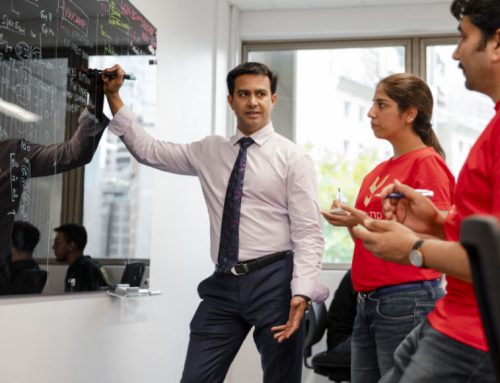8 Ways to Improve the Productivity of your Hybrid Team
Hybrid working has become the norm in many companies, with a combination of face-to-face and remote working. Although this offers more flexibility and autonomy to employees, it also poses communication and collaboration challenges. Adopting appropriate working methods is the only way for hybrid teams to be efficient and productive. What methods should you choose to easily manage your hybrid team?
One of the roles of managers that becomes particularly difficult with a hybrid team is the organization of the team’s work, of their own work as well as the dissemination of productivity best practices within their teams.
Here are 7 proven methods that we advise you to choose from to find what works best for you and your team:
- The Eisenhower Matrix: This method of prioritizing tasks was developed by President Eisenhower to help manage the multiple responsibilities of the White House. It consists of classifying tasks according to their importance and urgency, using a two-dimensional matrix. This approach makes it possible to identify the tasks to be tackled first, and thus to maximize productivity.
- The Pomodoro Technique: This time management method was invented by Francesco Cirillo in the 80s. It involves working on a task for 25 minutes, then taking a short break of 5 minutes. After four cycles of work, we take a longer break. This technique helps maintain focus on a specific task while avoiding mental fatigue.
- 5S: Developed by Toyota to improve production efficiency, this organizational method is based on five steps – sorting, storing, cleaning, standardizing and maintaining.
- Seiri (Sort) : The first S of the 5S method is to sort out and eliminate anything unnecessary in your workspace. This may include unnecessary documents, expired supplies, broken equipment, etc. It is important to keep only the items that are useful and necessary for your daily work.
- Seiton (Set in order) : The second S is setting your workspace in order. Once you have sorted and discarded unnecessary items, it is important to store the remaining items in such a way that they are easily accessible when you need them. Organize supplies and tools so that the most commonly used items are easily accessible.
- Seiso (Shine) : The third S is to make your workspace shine. Clean your workspace regularly to maintain a clean and healthy environment. This may include cleaning work surfaces, cleaning tools, dusting and vacuuming floors.
- Seiketsu (Standardize) : The fourth S is to standardize your work practices. Create standards for work practices, such as the use of security protocols, standard procedures, etc. Make sure everyone follows these standards to maintain consistency and efficiency.
- Shitsuke (Sustain) : The fifth and final S is to sustain discipline.
For the 5S method to be effective, it must be followed regularly. Teach all team members the 5S method and encourage them to follow it regularly to maintain an efficient work environment.
By applying this method to the work environment, one can reduce the time wasted searching for documents, files and tools and thus increase productivity.
- Getting Things Done (GTD): Designed by David Allen, this personal productivity system is based on five steps: capture, clarify, organize, reflect, and engage. By eliminating distractions and organizing tasks clearly and efficiently, team members can work more efficiently and with less stress.
Setting up the GTD (Getting Things Done) method may seem complex, but by following a few simple steps, you can quickly start using it effectively. Here is how to implement the GTD method:- Capture all tasks: Take the time to write down all the tasks, projects and ideas that come to mind, without worrying about their importance or urgency.
- Clarify each task: For each task, ask yourself if it is doable, and if you should do it yourself or if you can delegate it. If it takes less than 2 minutes, do it right away. If not, plan when you will do it and in what context.
- Organize your tasks: Use lists, folders, and tags to organize your tasks by context (work, home, etc.), importance, and urgency.
Reflect on your lists: Regularly review your lists and ensure that all tasks are up to date and that nothing has been forgotten. You can also delete tasks that are no longer relevant. - Trust the system: By using the GTD method, you can be sure that all tasks are recorded, organized and tracked. So you can focus on the most important tasks without worrying about missing something.
Setting up the GTD method can take a bit of time, but it’s worth it. By following these simple steps, you can quickly start being more organized, more efficient, and more productive.
- The Pareto principle: This rule of thumb, also called the 80/20 law, states that 80% of the results come from 20% of the causes. Here are 4 simple steps to follow to apply the Pareto principle:
- Identify the 20% most important tasks: Take the time to analyze your work and identify the tasks that have the greatest impact on your productivity. These are often the tasks that contribute the most to achieving your long-term goals.
- Prioritize those tasks: Once you’ve identified the most important tasks, prioritize them in your to-do list. Make sure you give them enough time and resources to complete them properly.
- Eliminate or minimize less important tasks: Identify tasks that are less important or don’t directly contribute to achieving your goals. Try to eliminate or minimize them by delegating or postponing them.
- Regularly reassess your priorities: The Pareto rule is dynamic and can change over time. It is therefore important to regularly re-evaluate your priorities and ensure that you are devoting enough time to the most important tasks.
By applying this rule to time management, one can focus on the most important and profitable tasks.
- The MoSCoW method: This project management methodology is used to prioritize features and tasks by classifying them into four categories:
- Must have,
- Should have,
- Could have and
- Won’t have.
Using this method, team members can prioritize tasks according to their importance and urgency, and thereby maximize their productivity.
- Deep work: This method of working, popularized by author Cal Newport, involves focusing on complex and mentally demanding tasks, without interruption, for prolonged periods of time. By eliminating distractions and focusing on specific tasks, team members can accomplish more in less time.
- Parkinson’s Law: This is a theory that states that work expands to fill available time, is another important consideration for improving your hybrid team’s productivity. It is important to set clear and realistic deadlines for tasks so that team members do not waste time extending them unnecessarily.
It is important to note that every team is different and there is no single method to improve productivity. It is therefore recommended to try different methods to find the ones that work best for your team. Also, it’s important to maintain clear and regular communication to ensure the team is on the same page.
Finally, remember to consider the individual needs of each team member to ensure optimal productivity by:
- setting up one-to-one meetings with each member of your team
- defining clear goals for each employee and driving them in a platform like Clickup
By using these methods and concepts, you can help your hybrid team improve productivity and succeed in an ever-changing work environment. By working together and adopting the methods that work best for your team, you can create the right hybrid work environment and achieve your goals as a team.







